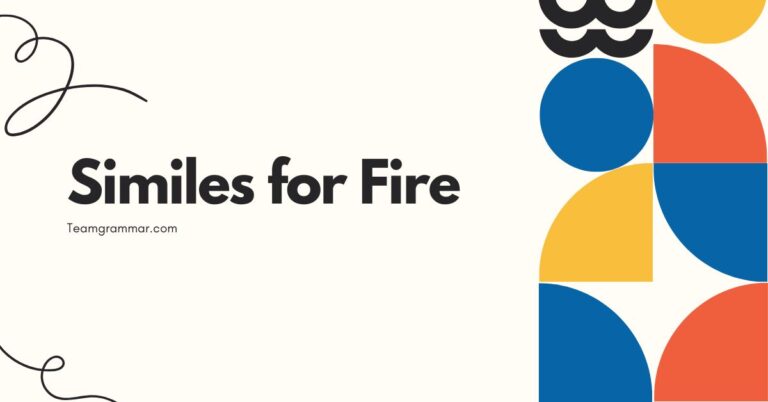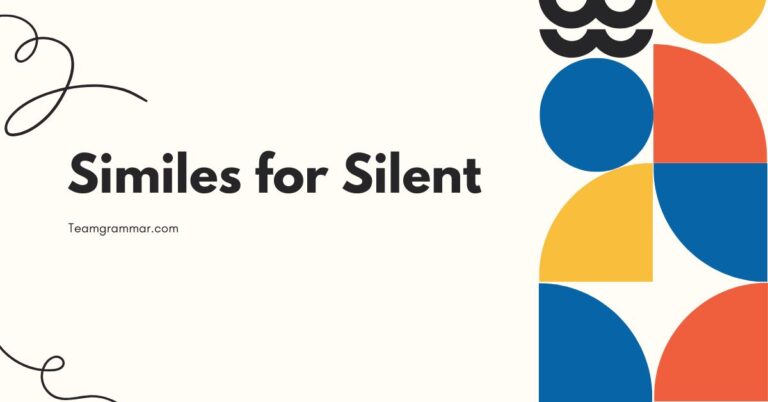31 Similes for Angry: Mastering Figurative Language
Understanding and using similes effectively is crucial for enhancing your writing and communication skills. Similes add color and depth to your descriptions, making them more vivid and engaging for your audience.
This article focuses specifically on similes used to describe anger, providing you with a comprehensive guide to mastering this figurative language technique. Whether you’re a student, a writer, or simply someone looking to improve their English proficiency, this guide will equip you with the knowledge and practice you need to use similes for ‘angry’ with confidence and creativity.
By the end of this article, you will be able to identify, understand, and create compelling similes that capture the intensity of anger.
This article will explore the definition of similes, their structural components, various types, and practical usage rules. We will also delve into common mistakes to avoid and provide extensive practice exercises to solidify your understanding.
Advanced topics and frequently asked questions will further enhance your grasp of this essential grammar concept. Let’s dive in and unlock the power of similes for expressing anger!
Table of Contents
- Definition of Similes
- Structural Breakdown
- Types of Similes
- Examples of Similes for Angry
- Usage Rules
- Common Mistakes
- Practice Exercises
- Advanced Topics
- FAQ
- Conclusion
Definition of Similes
A simile is a figure of speech that directly compares two different things, highlighting a shared quality or characteristic. Similes are used to make descriptions more vivid, relatable, and impactful by drawing a parallel between something familiar and something less known.
The key characteristic of a simile is the use of the words”like”or”as”to establish the comparison. Without these words, the comparison becomes a metaphor, which implies that one thing *is* another, rather than being *like* it.
Similes serve as a powerful tool in both writing and speech, allowing for more nuanced and creative expression. They can evoke specific emotions, create strong imagery, and help the audience understand a concept more easily.
In the context of describing anger, similes can capture the intensity, nature, and manifestation of this emotion in a way that is both descriptive and relatable. For example, saying someone is “as angry as a hornet” immediately conveys a sense of intense, stinging fury.
In essence, a simile is a bridge that connects two disparate concepts, illuminating a common ground and enriching the overall meaning. The effectiveness of a simile lies in the aptness of the comparison and its ability to resonate with the audience’s understanding and experiences.
Whether used in literature, poetry, or everyday conversation, similes add depth and vibrancy to the language.
Structural Breakdown
The structure of a simile is relatively straightforward, consisting of three main components: the subject being described, the comparison word (“like” or “as”), and the object or concept to which the subject is being compared. Understanding these components is crucial for constructing effective and meaningful similes.
1.Subject:This is the person, object, or concept that is being described. In the context of this article, the subject will often be a person or their anger.
For instance, in the simile “He was as angry as a bear,” the subject is “He.”
2.Comparison Word:This is the word that explicitly indicates a comparison is being made. The two most common comparison words are “like” and “as.” The choice between “like” and “as” often depends on the specific construction of the sentence and the desired rhythm or emphasis.
For example, “He roared like a lion” uses “like,” while “She was as furious as a storm” uses “as.”
3.Object of Comparison:This is the person, object, or concept to which the subject is being compared. The object of comparison should share a relevant characteristic with the subject to make the simile effective.
In the example “He was as angry as a bear,” the object of comparison is “a bear,” which is known for its potential for aggressive behavior.
The order of these components can sometimes be varied for stylistic effect, but the presence of the comparison word is essential for maintaining the simile structure. For example, instead of saying “She was as angry as a hornet,” you could say “As angry as a hornet, she stormed out of the room.” However, the core structure remains the same: subject, comparison word, and object of comparison.
Types of Similes
Similes can be categorized based on the aspect of anger they emphasize or the type of comparison they make. Understanding these different types can help you choose the most appropriate simile for a given context and create more nuanced descriptions of anger.
Similes Emphasizing Intensity
These similes focus on the degree or strength of the anger. They often use objects or concepts known for their power or ferocity to convey the intensity of the emotion.
Examples include: “as angry as a raging bull,” “like a volcano about to erupt,” and “as furious as a hurricane.”
Similes Emphasizing Appearance
These similes describe how anger manifests physically, such as facial expressions, body language, or other visible signs. Examples include: “red in the face like a tomato,” “eyes blazing like hot coals,” and “face contorted like a gargoyle.”
Similes Emphasizing Behavior
These similes focus on how anger affects a person’s actions or conduct. They often use animals or objects known for their aggressive or destructive behavior.
Examples include: “roaring like a lion,” “stomping around like an elephant,” and “snapping like a turtle.”
Similes Emphasizing Sound
These similes describe the sounds associated with anger, such as shouting, yelling, or other vocal expressions. Examples include: “screaming like a banshee,” “yelling like a drill sergeant,” and “growling like a wolf.”
Similes Emphasizing Control
These similes can be used to describe controlled or uncontrolled anger. They often use imagery that suggests restraint or lack thereof.
Examples include: “seething like a pressure cooker,” “simmering like a pot on the stove,” and “exploding like a bomb.”
Examples of Similes for Angry
This section provides an extensive list of similes for ‘angry,’ categorized to help you understand the different nuances and contexts in which they can be used. Each category includes multiple examples to inspire your own writing and speech.
General Anger
These similes describe anger in a general sense, without specifying the intensity, appearance, or behavior associated with it.
The following table provides examples of similes for general anger.
| Simile | Explanation |
|---|---|
| As angry as a wet hen | Describes someone who is irritable and easily angered. |
| Like a storm brewing | Suggests that anger is building up and about to explode. |
| As mad as a hatter | Implies irrational or eccentric anger. |
| As cross as two sticks | Describes someone who is very irritable and unpleasant. |
| Like a bear with a sore head | Suggests someone who is grumpy and easily annoyed. |
| As annoyed as a mosquito bite | Implies a minor but irritating level of anger. |
| Like a bee in a bottle | Describes someone who is agitated and restless with anger. |
| As irate as a customer with bad service | Suggests justified anger due to a negative experience. |
| Like a cornered animal | Implies that anger is a defensive reaction to feeling trapped. |
| As bitter as gall | Describes anger that is tinged with resentment and disappointment. |
| Like a pot about to boil over | Suggests that anger is reaching a critical point and could explode. |
| As testy as a toddler | Implies impatience and irritability, like a young child. |
| Like a shaken soda can | Describes suppressed anger that is about to burst out. |
| As prickly as a cactus | Suggests someone who is easily offended and quick to anger. |
| Like a dark cloud overhead | Implies a looming sense of anger and negativity. |
| As touchy as a raw nerve | Describes someone who is extremely sensitive and easily angered. |
| Like a volcano rumbling | Suggests underlying anger that could erupt at any moment. |
| As peevish as a spoiled child | Implies petty and unreasonable anger. |
| Like a fuse burning short | Describes anger that is quickly escalating and about to explode. |
| As resentful as an unappreciated worker | Suggests anger stemming from a perceived lack of recognition. |
| Like a coiled spring | Implies pent-up anger that is ready to be released. |
| As crabby as an old man | Describes someone who is generally grumpy and irritable. |
| Like a pressure cooker building steam | Suggests that anger is building up and needs to be released. |
Intense Anger
These similes describe anger that is particularly strong or extreme.
The following table provides examples of similes for intense anger.
| Simile | Explanation |
|---|---|
| As angry as a hornet | Suggests intense, stinging fury. |
| Like a raging bull | Implies uncontrolled and destructive anger. |
| As furious as a storm | Describes overwhelming and destructive anger. |
| Like a volcano erupting | Suggests a sudden and violent outburst of anger. |
| As wrathful as a vengeful god | Implies righteous and powerful anger. |
| Like a wildfire spreading | Describes anger that is quickly escalating and uncontrollable. |
| As incensed as a betrayed lover | Suggests intense anger stemming from betrayal. |
| Like a hurricane tearing through | Describes anger that is devastating and all-consuming. |
| As livid as a scalded cat | Implies extreme anger and distress. |
| Like a bomb exploding | Suggests a sudden and destructive release of anger. |
| As indignant as a wrongly accused person | Describes anger stemming from a sense of injustice. |
| Like a tsunami crashing | Suggests overwhelming and destructive anger. |
| As outraged as a community protesting | Implies collective and passionate anger. |
| Like a tornado ripping through | Describes anger that is chaotic and destructive. |
| As bitter as poison | Suggests intense resentment and animosity. |
| Like a nuclear reaction | Describes anger that is explosive and far-reaching in its consequences. |
| As ferocious as a lion | Implies fierce and aggressive anger. |
| Like a dragon breathing fire | Suggests powerful and destructive anger. |
| As apoplectic as a Victorian gentleman | Describes extreme anger leading to a loss of control. |
| Like a supernova exploding | Suggests a sudden and intensely bright outburst of anger. |
| As ballistic as a missile | Implies anger that is rapidly escalating and uncontrollable. |
| Like a freight train derailing | Describes anger that is chaotic and destructive. |
| As tempestuous as a stormy sea | Suggests intense and unpredictable anger. |
Suppressed Anger
These similes describe anger that is held back or hidden, often building up over time.
The following table provides examples of similes for suppressed anger.
| Simile | Explanation |
|---|---|
| Like a pressure cooker about to burst | Suggests that anger is building up and will eventually explode. |
| As seething as a cauldron | Implies simmering anger that is barely contained. |
| Like a volcano rumbling beneath the surface | Describes underlying anger that is threatening to erupt. |
| As tightly wound as a spring | Suggests pent-up anger that is ready to be released. |
| Like a shaken soda can | Describes anger that is building up pressure and could explode. |
| As smoldering as embers | Implies lingering anger that is still burning beneath the surface. |
| Like a coiled snake ready to strike | Suggests hidden anger that is waiting for an opportunity to be expressed. |
| As bottled up as a genie | Describes anger that is trapped and longing to be released. |
| Like a dam holding back a flood | Suggests that anger is being contained with great effort. |
| As simmering as a pot on the stove | Implies anger that is slowly building up over time. |
| Like a tightly closed fist | Describes anger that is being held back with force. |
| As restrained as a caged animal | Suggests anger that is being suppressed due to external constraints. |
| Like a dark cloud gathering | Describes a growing sense of anger and negativity. |
| As pent-up as a geyser | Implies anger that is building up pressure and will eventually erupt. |
| Like a slow-burning fuse | Suggests that anger is gradually increasing over time. |
| As contained as a nuclear reactor | Describes anger that is being carefully controlled to prevent a meltdown. |
| Like a sleeping giant | Suggests that anger is dormant but could awaken at any moment. |
| As hushed as a gathering storm | Implies a sense of impending anger that is being kept quiet. |
| Like a bomb ticking down | Describes anger that is counting down to an inevitable explosion. |
| As carefully controlled as a wildfire | Suggests that anger is being managed to prevent it from spreading. |
Sudden Anger
These similes describe anger that arises quickly and unexpectedly.
The following table provides examples of similes for sudden anger.
| Simile | Explanation |
|---|---|
| Like a lightning strike | Suggests a sudden and intense burst of anger. |
| As explosive as a firecracker | Implies a sudden and startling outburst of anger. |
| Like a jack-in-the-box popping open | Describes anger that appears unexpectedly and suddenly. |
| As spontaneous as a flash fire | Suggests anger that ignites quickly and without warning. |
| Like a gunshot echoing | Describes a sudden and jarring expression of anger. |
| As instantaneous as a camera flash | Implies anger that appears in an instant. |
| Like a switch being flipped | Suggests a sudden and complete change to an angry state. |
| As abrupt as a slammed door | Describes anger that is expressed suddenly and forcefully. |
| Like a rocket launching | Suggests a rapid and powerful surge of anger. |
| As immediate as a reflex | Implies anger that is an automatic and instinctive response. |
| Like a startled animal | Describes anger that is triggered by a sudden surprise. |
| As unexpected as an ambush | Suggests anger that catches someone off guard. |
| Like a trap snapping shut | Describes anger that is sudden and inescapable. |
| As swift as a striking snake | Implies anger that is quick and dangerous. |
| Like a geyser erupting | Suggests a sudden and powerful outburst of anger. |
| As precipitous as a cliff edge | Describes anger that is sudden and potentially dangerous. |
| Like a bomb detonating | Suggests a sudden and destructive release of anger. |
| As unannounced as a surprise storm | Implies anger that appears without any warning. |
| Like a dam breaking | Describes a sudden and overwhelming surge of anger. |
| As out-of-the-blue as a meteor strike | Suggests anger that is completely unexpected and devastating. |
Irrational Anger
These similes describe anger that is unreasonable or disproportionate to the situation.
The following table provides examples of similes for irrational anger.
| Simile | Explanation |
|---|---|
| As mad as a hatter | Implies irrational and eccentric anger. |
| Like a child throwing a tantrum | Describes anger that is immature and unreasonable. |
| As nonsensical as a tea party in Wonderland | Suggests anger that is completely illogical and absurd. |
| Like tilting at windmills | Describes anger that is directed at imaginary or inconsequential targets. |
| As preposterous as a fish on a bicycle | Implies anger that is ridiculous and out of place. |
| Like a dog barking at the moon | Suggests anger that is futile and pointless. |
| As absurd as a penguin in the desert | Describes anger that is completely inappropriate for the situation. |
| Like a cat chasing its tail | Suggests anger that is self-defeating and unproductive. |
| As illogical as a dream | Implies anger that is disconnected from reality. |
| Like a broken record skipping | Describes anger that is repetitive and nonsensical. |
| As unreasonable as a conspiracy theory | Suggests anger that is based on unfounded beliefs. |
| Like a headless chicken running around | Describes anger that is chaotic and directionless. |
| As pointless as arguing with a brick wall | Implies anger that is unproductive and futile. |
| Like a squirrel burying nuts in concrete | Suggests anger that is misdirected and ineffective. |
| As erratic as a pinball machine | Describes anger that is unpredictable and uncontrolled. |
| Like a clown with a flat tire | Suggests anger that is comical and pathetic. |
| As bizarre as a purple elephant | Describes anger that is strange and out of the ordinary. |
| Like a fish out of water | Suggests anger that is uncomfortable and out of place. |
| As irrational as a superstition | Implies anger that is based on unfounded fears. |
| Like a scarecrow guarding an empty field | Describes anger that is symbolic but ultimately ineffective. |
Usage Rules
Using similes effectively involves understanding the rules that govern their construction and application. While similes offer creative freedom, adhering to certain guidelines ensures clarity and impact.
1.Clarity:The comparison should be clear and easily understood. The audience should be able to recognize the shared characteristic between the subject and the object of comparison.
Avoid obscure or overly complex comparisons that might confuse the reader.
2.Relevance:The object of comparison should be relevant to the subject being described. The shared characteristic should be meaningful and contribute to the overall description.
Avoid comparisons that are arbitrary or nonsensical.
3. Originality: While common similes can be effective, strive for originality to make your writing more engaging and memorable. Think creatively about potential comparisons that haven’t been overused.
4.Context:Consider the context in which the simile is being used. The simile should be appropriate for the tone, style, and audience of the writing or speech.
Avoid using similes that are offensive or insensitive.
5. Avoid Clichés: While some clichés have their place, overuse can make your writing seem uninspired. Try to find fresh and original comparisons that will make your descriptions stand out.
6. Use Sparingly: While similes can enhance your writing, overuse can make it seem forced and unnatural. Use similes strategically to highlight key aspects of your descriptions, rather than peppering them throughout your work.
7. Consistency: Ensure that the simile is consistent with the overall tone and style of your writing. Avoid using similes that clash with the other elements of your work.
Common Mistakes
Even experienced writers can make mistakes when using similes. Being aware of these common errors can help you avoid them and improve the effectiveness of your writing.
1. Mixing Metaphors and Similes: Confusing metaphors and similes is a common mistake. Remember that a simile uses “like” or “as” to make a comparison, while a metaphor implies that one thing *is* another.
- Incorrect: He was a raging bull, as angry as. (Mixing metaphor and simile)
- Correct: He was like a raging bull. (Simile)
- Correct: He was a raging bull. (Metaphor)
2. Using Clichéd Similes: Overusing common similes can make your writing seem unoriginal and uninspired.
- Clichéd: As angry as a wet hen.
- Improved: As angry as a cornered badger.
3. Creating Unclear Comparisons: The comparison should be clear and easily understood. Avoid using obscure or overly complex comparisons that might confuse the reader.
- Unclear: He was as angry as a quantum particle.
- Improved: He was as angry as a swarm of bees.
4. Using Irrelevant Comparisons: The object of comparison should be relevant to the subject being described. The shared characteristic should be meaningful and contribute to the overall description.
- Irrelevant: He was as angry as a stapler.
- Improved: He was as angry as a roaring fire.
5. Overusing Similes: While similes can enhance your writing, overuse can make it seem forced and unnatural.
- Overuse: He was as angry as a hornet, like a volcano ready to erupt, as furious as a storm.
- Improved: He was as angry as a hornet, his face red and his fists clenched.
Practice Exercises
These exercises will help you practice identifying, completing, and creating similes for ‘angry.’ Each exercise includes multiple questions and answers to test your understanding and improve your skills.
Exercise 1: Identify the Simile
In each of the following sentences, identify the simile. Underline the simile and explain what two things are being compared and what quality they share.
The following table provides questions for identifying the simile.
| Question | Answer |
|---|---|
| 1. She was as furious as a storm, her voice booming like thunder. | Simile: as furious as a storm. Comparison: She and a storm. Shared quality: Intensity. |
| 2. He roared like a lion, his face red with rage. | Simile: roared like a lion. Comparison: He and a lion. Shared quality: Loudness and ferocity. |
| 3. The crowd was as angry as a disturbed hive, their shouts echoing through the streets. | Simile: as angry as a disturbed hive. Comparison: The crowd and a disturbed hive. Shared quality: Agitation and aggression. |
| 4. He was seething like a pressure cooker, his anger building up inside him. | Simile: seething like a pressure cooker. Comparison: He and a pressure cooker. Shared quality: Building internal pressure. |
| 5. Her eyes flashed like lightning, her anger sudden and intense. | Simile: flashed like lightning. Comparison: Her eyes and lightning. Shared quality: Suddenness and intensity. |
| 6. He stomped around like an elephant, his anger shaking the room. | Simile: stomped around like an elephant. Comparison: He and an elephant. Shared quality: Heavy and destructive movement. |
| 7. She was as bitter as gall, her words dripping with resentment. | Simile: as bitter as gall. Comparison: She and gall. Shared quality: Unpleasant and resentful. |
| 8. He was as mad as a hatter, his behavior completely irrational. | Simile: as mad as a hatter. Comparison: He and a hatter. Shared quality: Irrationality. |
| 9. The protesters were as outraged as a community betrayed, their voices rising in unison. | Simile: as outraged as a community betrayed. Comparison: The protesters and a community betrayed. Shared quality: Strong sense of injustice. |
| 10. He was like a volcano about to erupt, his anger barely contained. | Simile: like a volcano about to erupt. Comparison: He and a volcano. Shared quality: Potential for explosive outburst. |
Exercise 2: Complete the Simile
Complete the following similes by filling in the missing word or phrase. Choose a word or phrase that creates a clear and relevant comparison.
The following table provides questions for completing the similes.
| Question | Answer |
|---|---|
| 1. He was as angry as a ________. | hornet |
| 2. She roared like a ________. | lion |
| 3. His anger was like a ________ about to explode. | bomb |
| 4. They were as furious as a ________. | storm |
| 5. He seethed like a ________. | pressure cooker |
| 6. Her eyes flashed like ________. | lightning |
| 7. He stomped around like an ________. | elephant |
| 8. She was as bitter as ________. | gall |
| 9. He was as mad as a ________. | hatter |
| 10. The protesters were as outraged as a ________ betrayed. | community |
Exercise 3: Create Your Own Similes
Create your own similes to describe the following scenarios. Be creative and use vivid language to capture the intensity of the anger.
The following table provides scenarios for creating similes.
| Scenario | Example Answer |
|---|---|
| 1. Describe someone who is extremely angry after being betrayed. | He was as enraged as a wounded animal, his trust shattered into a million pieces. |
| 2. Describe someone who is trying to suppress their anger. | She was like a volcano dormant, the lava of her anger threatening to erupt with every tremor. |
| 3. Describe someone who suddenly becomes angry. | His anger flared like a match struck in a dark room, illuminating the sudden fury in his eyes. |
| 4. Describe a crowd of people who are angry about an injustice. | The crowd was as incensed as a disturbed anthill, their collective anger rising like a swarm. |
| 5. Describe someone who is irrationally angry. | He was as mad as a March hare, his anger fueled by nothing more than his own twisted logic. |
| 6. Describe someone who is simmering with anger over a long period of time. | She was as bitter as aged vinegar, her anger fermenting over years of perceived slights. |
| 7. Describe the sound of someone yelling in anger. | His voice cracked like thunder, each word a lightning bolt of rage. |
| 8. Describe the physical appearance of someone who is very angry. | His face was as red as a beet, veins throbbing on his forehead like angry worms. |
| 9. Describe the actions of someone who is consumed by anger. | He paced like a caged tiger, his every step a testament to his inner turmoil. |
| 10. Describe the feeling of being angry. | Anger coursed through him like molten lava, burning away any semblance of calm. |
Advanced Topics
For advanced learners, understanding the nuances of simile usage can further enhance their writing and communication skills. This section explores more complex aspects of similes, including extended similes, mixed similes, and cultural considerations.
1.Extended Similes:An extended simile is a simile that is developed over several lines or sentences, providing a more detailed and elaborate comparison. This technique can be used to create more vivid and impactful descriptions.
For example, instead of saying “He was as angry as a hornet,” you could say: “He was as angry as a hornet, buzzing with fury, ready to sting anyone who came too close, his eyes darting around like a trapped insect.”
2.Mixed Similes:A mixed simile combines elements of different similes, often creating a humorous or surreal effect. While mixed metaphors are generally discouraged, mixed similes can be used intentionally for stylistic purposes.
For example: “He was as angry as a hornet in a pressure cooker,” combining the intensity of a hornet with the suppressed nature of a pressure cooker.
3.Cultural Considerations:The effectiveness of a simile can depend on the cultural background of the audience. Similes that rely on specific cultural references or idioms may not be understood by everyone.
Consider your audience when choosing similes and be mindful of potential cultural differences.
4. Subverting Expectations: Sometimes, the most effective similes are those that
subvert expectations or challenge conventional comparisons. By using unexpected or unconventional objects of comparison, you can create a more memorable and impactful simile.
For example, instead of saying “He was as angry as a lion,” you could say “He was as angry as a librarian who just found a book with its pages torn.”
FAQ
This section addresses frequently asked questions about similes for ‘angry,’ providing additional clarity and guidance.
Q: What is the difference between a simile and a metaphor?
A: A simile uses “like” or “as” to make a direct comparison, while a metaphor implies that one thing *is* another. For example, “He is like a lion” (simile) versus “He is a lion” (metaphor).
Q: Can I use similes in formal writing?
A: Yes, but use them judiciously. Similes can add color and depth to formal writing, but avoid overuse or comparisons that are too informal or colloquial.
Q: How can I make my similes more original?
A: Think creatively about potential comparisons that haven’t been overused. Consider specific details or unique characteristics of the subject and look for unexpected parallels.
Q: What should I do if I can’t think of a good simile?
A: Take a break and come back to it later. Sometimes, stepping away from the problem and returning with a fresh perspective can help.
You can also brainstorm with others or consult a thesaurus for inspiration.
Q: How do I avoid using clichés in my similes?
A: Be mindful of common similes and actively seek out alternatives. Use a thesaurus or dictionary to explore different options and challenge yourself to come up with original comparisons.
Conclusion
Mastering similes for ‘angry’ is a valuable skill that can significantly enhance your writing and communication. By understanding the definition, structure, types, and usage rules of similes, you can create vivid and impactful descriptions that resonate with your audience.
Avoiding common mistakes and practicing regularly will further refine your abilities, allowing you to express the nuances of anger with creativity and precision. Whether you’re a student, a writer, or simply someone looking to improve their language skills, the knowledge and exercises provided in this article will empower you to use similes for ‘angry’ with confidence and effectiveness.
Embrace the power of figurative language and unlock new dimensions in your expression!







